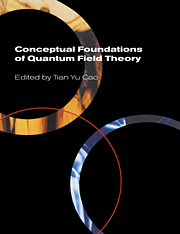Book contents
- Frontmatter
- Contents
- List of contributors
- Preface
- Photographs of the conference
- Introduction: Conceptual issues in quantum field theory
- Part One Philosophers' interest in quantum field theory
- Part Two Three approaches to the foundations of quantum field theory
- Part Three
- Part Four Mathematics, statistics and quantum field theory
- 8 Renormalization group theory: its basis and formulation in statistical physics
- 9 Where does quantum field theory fit into the big picture?
- 10 The unreasonable effectiveness of quantum field theory
- 11 Comments: The quantum field theory of physics and of mathematics
- Part Five Quantum field theory and space-time
- Part Six
- Part Seven Renormalization group
- Part Eight Non-Abelian gauge theory
- Part Nine The ontology of particles or fields
- Part Ten
- Name index
- Subject index
8 - Renormalization group theory: its basis and formulation in statistical physics
Published online by Cambridge University Press: 22 September 2009
- Frontmatter
- Contents
- List of contributors
- Preface
- Photographs of the conference
- Introduction: Conceptual issues in quantum field theory
- Part One Philosophers' interest in quantum field theory
- Part Two Three approaches to the foundations of quantum field theory
- Part Three
- Part Four Mathematics, statistics and quantum field theory
- 8 Renormalization group theory: its basis and formulation in statistical physics
- 9 Where does quantum field theory fit into the big picture?
- 10 The unreasonable effectiveness of quantum field theory
- 11 Comments: The quantum field theory of physics and of mathematics
- Part Five Quantum field theory and space-time
- Part Six
- Part Seven Renormalization group
- Part Eight Non-Abelian gauge theory
- Part Nine The ontology of particles or fields
- Part Ten
- Name index
- Subject index
Summary
The nature and origins of renormalization group ideas in statistical physics and condensed matter theory are recounted informally, emphasizing those features of prime importance in these areas of science in contradistinction to quantum field theory, in particular: critical exponents and scaling, relevance, irrelevance and marginality, universality, and Wilson's crucial concept of flows and fixed points in a large space of Hamiltonians.
Contents
Foreword
1 Introduction
2 Whence came renormalization group theory?
3 Where stands the renormalization group?
4 Exponents, anomalous dimensions, scale invariance and scale dependence
5 The challenges posed by critical phenomena
6 Exponent relations, scaling, and irrelevance
7 Relevance, crossover, and marginality
8 The task for renormalization group theory
9 Kadanoff's scaling picture
10 Wilson's quest
11 The construction of renormalization group transformations: the epsilon expansion
12 Flows, fixed points, universality and scaling
13 Conclusions
Acknowledgments
Selected bibliography
Appendix A Asymptotic behavior
Appendix B Unitarity of the renormalization group
Appendix C Nature of a semigroup
Foreword
It was a pleasure to participate in the Colloquium cosponsored by the Departments of Philosophy and of Physics at Boston University “On the Foundations of Quantum Field Theory.” In the full title, this was preceded by the phrase: “A Historical Examination and Philosophical Reflections,” which set the aims of the meeting. Naturally, the participants were mainly high-energy physicists, experts in field theories, and interested philosophers of science.
- Type
- Chapter
- Information
- Conceptual Foundations of Quantum Field Theory , pp. 89 - 135Publisher: Cambridge University PressPrint publication year: 1999
- 5
- Cited by



